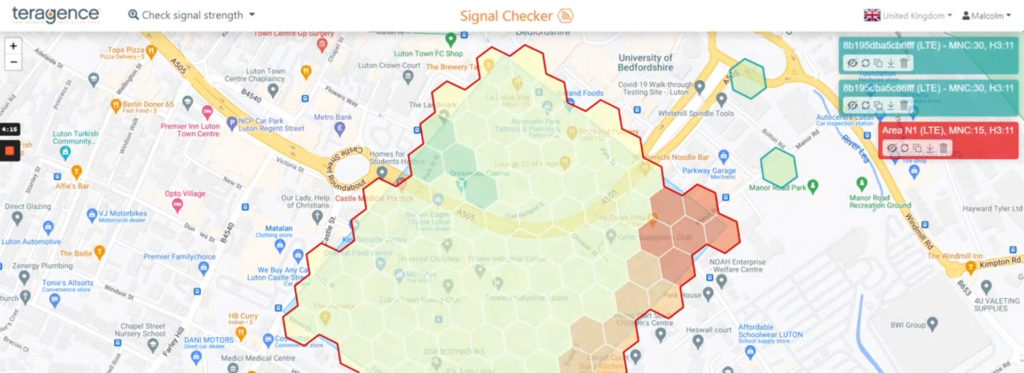Mobile Network Coverage: Strategic Insights for Local Authorities
Got it covered?

In a series of three blog posts, Teragence outlines why local authorities should:
- monitor network coverage,
- go about doing so,
- and what they can do with the information.
As we navigate the rapidly evolving digital landscape, one facet of our infrastructure stands paramount – mobile network coverage. In the era of hyper-connectivity, reliable and comprehensive network coverage is more than a mere convenience. It is a vital conduit for socio-economic development, environmental sustainability, and digital inclusion.
This article explores why local authorities should actively manage and monitor mobile network coverage, the strategies to achieve this, and the profound impacts that efficient network coverage can have on local communities and their economies. From fostering digitization to enabling the Internet of Things, from supporting local businesses to facilitating the rollout of electric vehicles, the breadth of mobile network coverage’s influence is profound.
Join us as we delve into the multi-faceted benefits of good mobile network coverage and how we can effectively measure and optimize it for a better future.
- The Benefits Of Good Mobile Network Coverage
- Efficient Network Coverage: Digitalisation Benefits and Impacts
- Local Economy Benefits
- IoT Efficiencies And Carbon Reduction Benefits
- EV Hyper-Connectivity Benefits
- Teragence Mobile Signal Strength Checker
Part 1: The Benefits Of Good Mobile Network Coverage
Local authorities take an increasing interest in mobile coverage, driven by their general interest in “digital inclusion”. People’s need for digital technologies and connectivity is crucial for work, global engagement, and economic growth.
However, good mobile coverage enables specific economic, social, and environmental advantages beyond its high-level benefits.
Efficient Network Coverage: Digitalisation Benefits and Impacts
For many people, mobile broadband is their primary internet access mechanism. As local authorities look for cost savings through their services digitisation, they must make sure that all citizens can easily access these services with good network coverage.
Local Economy Benefits

Bad mobile coverage has direct, measurable impact on the local economy:
- small tradesmen conduct their business over mobiles,
- shops and market traders need their payment terminals to connect to take payment,
- local hotels and other tourist accommodation need to have good mobile coverage to attract tourists and business people.
Much of the flexible, nimble activity that makes a local community tick is nowadays reliant on mobile phone coverage.
IoT Efficiencies And Carbon Reduction Benefits
IoT (“Internet of Things”) refers to the idea of connecting various devices to the internet like:
- pollution meters,
- water meters,
- footfall counters,
- social care infrastructure.
This enables remote monitoring and management, leading to cost-efficiency and carbon reduction. Every remotely monitored and managed device reduces the need for a site visit and associated cost in terms of people-time and carbon. But if the coverage is not there, these benefits cannot be realised.
EV Hyper-Connectivity Benefits
The adoption of Electrical Vehicles (EVs) is an important pillar in the UK’s carbon reduction strategy. But EVs need charge points and charge points need mobile coverage. Most mobile charge points rely on mobile for their metering and billing. This means that if a charge point does not have good mobile coverage from one of the four main UK operators, it has made itself unavailable to roughly a quarter of the population. So good mobile coverage is key to the EV rollout strategy.
Keeping tabs on mobile network coverage is not straightforward. It’s easy to tell whether an area has electricity or water, but mobile coverage is far less tangible, harder to pin down. The coverage maps provided by the operators themselves are notoriously unreliable, lack granularity and are difficult to compare. So local authorities are increasingly compiling their own maps. In our next installment we will outline the different data collection methods and compares them in terms of effectiveness and efficiency.
Teragence Mobile Signal Strength Checker
in the context of monitoring mobile network coverage, offers a powerful solution with its Mobile Signal Strength Checker. Local authorities can gain comprehensive insights into mobile coverage, allowing them to make informed decisions and take proactive measures to improve network coverage where needed. Teragence Signal Checker provides accurate data and analytics, enabling authorities to assess coverage gaps, plan infrastructure improvements, and enhance communication strategies. Check our Mobile Network Coverage Mapping Suite for more details.
